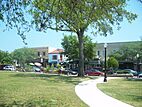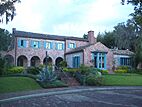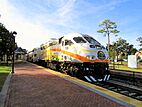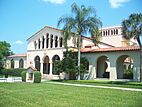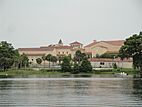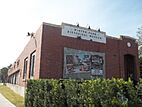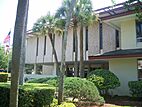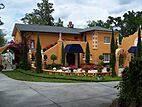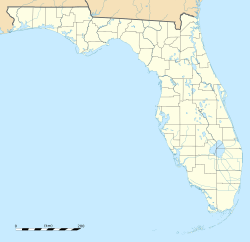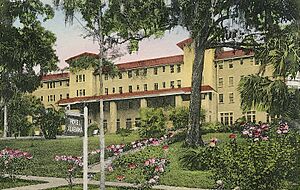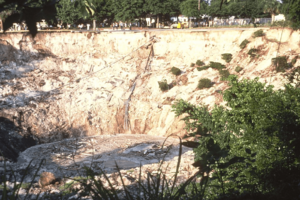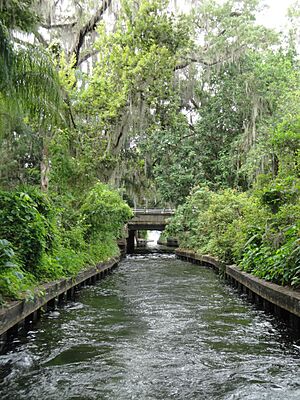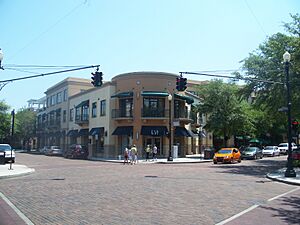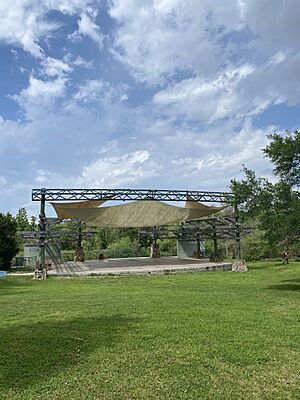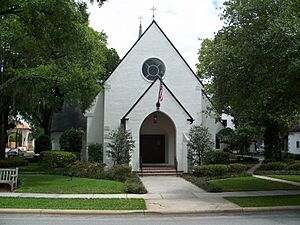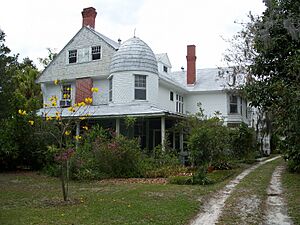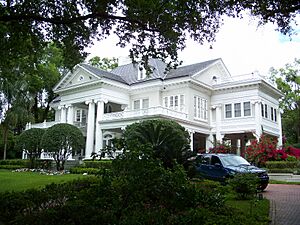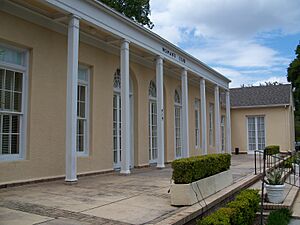Winter Park, Florida facts for kids
Quick facts for kids
Winter Park, Florida
|
|||
|---|---|---|---|
| City of Winter Park | |||
|
Downtown Winter Park
Winter Park station
Annie Russell Theatre
Winter Park City Hall
|
|||
|
|||
| Motto(s):
"City of Culture and Heritage"
|
|||
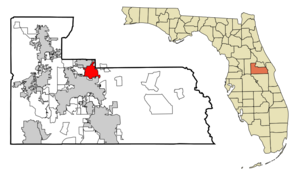
Location in Orange County and the state of Florida
|
|||
| Country | United States | ||
| State | Florida | ||
| County | Orange | ||
| Settled (Lakeview) | 1858 | ||
| Settled (Osceola) | 1870 | ||
| Incorporated (Town of Winter Park) | October 21, 1887 | ||
| Incorporated (City of Winter Park) | 1925 | ||
| Government | |||
| • Type | Commission–Manager | ||
| Area | |||
| • Total | 10.38 sq mi (26.89 km2) | ||
| • Land | 8.76 sq mi (22.70 km2) | ||
| • Water | 1.62 sq mi (4.19 km2) | ||
| Elevation | 92 ft (28 m) | ||
| Population
(2020)
|
|||
| • Total | 29,795 | ||
| • Density | 3,400.09/sq mi (1,312.71/km2) | ||
| Time zone | UTC-5 (Eastern (EST)) | ||
| • Summer (DST) | UTC-4 (EDT) | ||
| ZIP code(s) |
32789, 32790 (PO box), 32792, 32793 (PO box)
|
||
| Area code(s) | 407, 689 | ||
| FIPS code | 12-78300 | ||
| GNIS feature ID | 0293428 | ||
Winter Park is a city in Orange County, Florida, United States. About 29,795 people lived there in 2020. It is part of the larger Orlando area.
Winter Park was started as a vacation spot by rich people from the northern U.S. in the late 1800s and early 1900s. Its main street, Park Avenue, is in the center of town. It has city buildings, shops, art galleries, a private college (Rollins College), museums, a park, and a train station. You can also find a golf course, a historic cemetery, and a beach there.
Contents
History of Winter Park
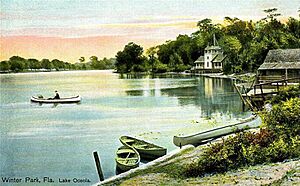
The first people to live in the Winter Park area were the Muscogee people. They mixed with other Native American groups to form a new culture called "Seminole". This name means "wild" or "runaway men" in their language.
Europeans first settled here in 1858. David Mizell Jr. bought land near Lakes Virginia, Mizell, and Berry. A small town grew around his land, first called Lake View. In 1870, it got a post office and was renamed Osceola.
The area grew much faster after 1880. A railroad track was built connecting Orlando and Sanford. Soon after, Loring Chase came from Chicago to get better from a lung illness. He found the beautiful lakes east of the railroad. He teamed up with Oliver E. Chapman, a rich man from New England.
On July 4, 1881, they bought a large piece of land for $13,000. They planned the town of Winter Park on this land. For the next four years, they laid out streets and built a town hall and a store. They also planted orange trees. All buildings had to follow certain style rules. Winter Park was a very planned city, which you can still see in its grid-like streets. They promoted the town to people in the north looking for a warm place to spend the winter. During this time, the Winter Park Post Office opened, and the railroad built a station.
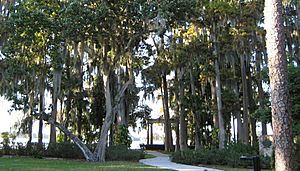
In 1885, a group of business people started the Winter Park Company. Chase and Chapman sold the town to this new company. Land prices went up very quickly, from less than $2 per acre to over $200. This fast rise in land prices was common in Florida's history.
In 1885, the Congregational Assembly of Florida started Rollins College. It was the first four-year college in the state. Today, Rollins College is a very important part of Winter Park's history and culture. It is one of the most expensive colleges in Florida. Rollins is a good liberal arts school with about 2,000 students. It also has a business program.
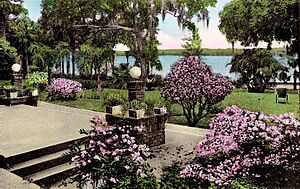
In 1886, the Seminole Hotel opened on Lake Osceola. This was a fancy resort with gas lights, steam heating, a string orchestra, and a bowling alley. This area is now a street called Kiwi Circle, part of a very nice neighborhood. On October 21, 1887, the town was officially named the "Town of Winter Park". In 1925, it became the "City of Winter Park".
Presidential Visits to Winter Park
The first president to visit Winter Park was Chester A. Arthur. He said Winter Park was "the prettiest place I have seen in Florida." President Grover Cleveland visited on February 23, 1888. He enjoyed a horse cart ride and said it was the best part of his Florida trip. The New York Times reported that the town's founders had done a good job.
For the next four years, Winter Park became a popular winter vacation spot for people from the north. President Franklin D. Roosevelt visited in March 1936. He received an honorary degree from Rollins College.
President Barack Obama visited Rollins College on August 2, 2012. He gave a speech there as part of his re-election campaign.
Winter Park Public Library
The Winter Park Public Library used to be at 460 E. New England Avenue. It started in 1885 when nine women created a lending library for their small community. The library moved to a new, modern building in late 2021. It was designed by a famous architect named Sir David Adjaye.
Peacocks in Winter Park
In 1904, Charles Hosmer Morse became the biggest landowner in Winter Park. In the 1920s, he bought more land between Lakes Virginia, Berry, and Mizell. In 1945, Morse's granddaughter Jeannette and her husband Hugh McKean moved to the land. Soon after, they added peacocks.
Today, this land is a nature preserve with an orange grove and over 30 peacocks. People in Winter Park think of the peacocks as pets for the whole community. The peacock is on the official Winter Park seal and is protected by the city. Peacocks often walk around in neighborhoods, especially in Windsong. Residents there often help take care of them.
The Winter Park Sinkhole Event
A sinkhole is a hole in the ground that opens up when the land above a cave or underground space collapses. In 1972, an expert named Henry Swanson warned that too much building and water use could cause sinkholes in Orange County. He said the west Winter Park area was especially at risk.
In May 1981, when water levels in Florida's underground limestone were very low, a huge sinkhole opened. It appeared near Denning Drive and Fairbanks Avenue.
The sinkhole first showed up on the evening of May 8, 1981, near Mae Rose Williams' house. Within hours, a large tree near her house fell into the hole. The next morning, the hole grew to almost 40 feet (12 m) wide. Mae Rose Williams heard a noise "like giant beavers chewing" as the hole got bigger. By noon, her home was slipping into the hole, so she and her family moved out. That afternoon, her house fell into the sinkhole.
The hole eventually grew to 320 feet (98 m) wide and 90 feet (27 m) deep. Many things fell into it: five Porsches from a repair shop, a pickup truck, the Winter Park city swimming pool, and parts of Denning Drive. By May 9, about 250,000 cubic yards of earth had fallen. The damage was estimated to be between $2 million and $4 million. Engineers called it "the largest sinkhole event witnessed by man" caused by natural reasons.
The sinkhole became a popular tourist spot in the summer of 1981. People sold food, balloons, and T-shirts. The city of Winter Park sold photos of the sinkhole to teach people about them and to encourage tourism. The sinkhole started to fill with water, but on July 19, the water level suddenly dropped by 15 to 20 feet (4.6 to 6.1 m).
After a while, the city worked to fix the damage. Workers got four of the six vehicles out of the sinkhole. The other two, along with Mae Rose Williams' home, are still at the bottom of the lake that formed. Engineers filled the bottom with dirt and concrete. Divers in 2009 said the lake has been used to get rid of unwanted vehicles. The sinkhole has been mostly quiet since then, except for one time in 1987 when the bottom dropped another 20 feet (6.1 m).
The Langford Resort Hotel
The Langford Hotel was a famous place in Central Florida for many years. It was a social center and a way for people to visit "Old Florida" attractions.
Many famous guests stayed there, including Dean Martin, Frank Sinatra, Ray Charles, Larry King, and John Denver. President Ronald Reagan and his wife Nancy Reagan celebrated their 24th wedding anniversary there. Reagan also gave a speech at Rollins College and stayed at the Langford in 1976.
The Langford Hotel closed and was torn down in late 1999. Part of the land now has luxury apartments. In 2014, a new hotel called the Alfond Inn opened on the site of the old Langford Hotel. Rollins College owns and runs the Alfond Inn. Money from the hotel helps fund scholarships for students at Rollins College.
The Temple Grove Orange Trees
An orange grove, called the Temple Grove, used to be on the south side of Palmer Avenue. A special type of orange, the temple orange, grew there. It was first noticed by the son of Louis A. Hakes, who owned the grove. The temple orange became well-known in 1917. Later, Myron E. Gillett and his son planted the largest orange grove in the world in the 1920s in Temple Terrace, Florida.
Winter Park Sidewalk Art Festival
The Winter Park Sidewalk Art Festival is one of the oldest and largest outdoor art festivals in the country. It is ranked among the top shows by art magazines. In 2012, about 1,200 artists from all over the world applied to be in the show. A group of judges chose 225 artists to display their work.
The festival is praised for helping art and art education in Central Florida. A group of volunteers runs the festival every year.
Geography of Winter Park
Winter Park is located at 28°35′46″N 81°20′48″W / 28.59611°N 81.34667°W. It is northeast of and next to Orlando. The city's height above sea level is between 66 and 97 feet (20 and 30 m).
The city covers about 10.15 square miles (26.3 km2). Of this, 8.7 square miles (22.5 km2) is land and 1.5 square miles (3.9 km2) is water. Winter Park is surrounded by a chain of lakes. These lakes are connected by canals. The canals were first built to control floods and to move logs to a sawmill. The lakes are popular for boating, watersports, fishing, and swimming.
An old railroad path, called the "Dinky Line", runs through Winter Park. This path is now a walking and biking trail called the Cady Way Trail. It connects to other trails and goes towards downtown Orlando and Oviedo.
SunRail operates a train line through Winter Park. There is an Amtrak and SunRail commuter train station in downtown's historic Central Park.
Climate in Winter Park
The weather in Winter Park has hot, humid summers and usually mild winters. It has a humid subtropical climate.
Population and People
| Historical population | |||
|---|---|---|---|
| Census | Pop. | %± | |
| 1890 | 270 | — | |
| 1900 | 366 | 35.6% | |
| 1910 | 570 | 55.7% | |
| 1920 | 1,078 | 89.1% | |
| 1930 | 3,686 | 241.9% | |
| 1940 | 4,715 | 27.9% | |
| 1950 | 8,250 | 75.0% | |
| 1960 | 17,162 | 108.0% | |
| 1970 | 21,895 | 27.6% | |
| 1980 | 22,339 | 2.0% | |
| 1990 | 22,242 | −0.4% | |
| 2000 | 24,090 | 8.3% | |
| 2010 | 27,852 | 15.6% | |
| 2020 | 29,795 | 7.0% | |
| U.S. Decennial Census Florida Department of Agriculture |
|||
| Race | Pop 2010 | Pop 2020 | % 2010 | % 2020 |
|---|---|---|---|---|
| White (NH) | 22,755 | 21,852 | 81.70% | 73.34% |
| Black or African American (NH) | 2,034 | 2,055 | 7.30% | 6.90% |
| Native American or Alaska Native (NH) | 35 | 40 | 0.13% | 0.13% |
| Asian (NH) | 632 | 1,061 | 2.27% | 3.56% |
| Pacific Islander or Native Hawaiian (NH) | 5 | 8 | 0.02% | 0.03% |
| Some other race (NH) | 52 | 143 | 0.19% | 0.48% |
| Two or more races/Multiracial (NH) | 396 | 1,119 | 1.42% | 3.76% |
| Hispanic or Latino (any race) | 1,943 | 3,517 | 6.98% | 11.80% |
| Total | 27,852 | 29,795 |
In 2020, Winter Park had 29,795 people, 13,072 households, and 7,055 families. The population density was about 3,401 people per square mile (1,312.7 per km2).
About 22.8% of households had children under 18. About 41.0% were married couples. The average household size was 2.22 people. The average family size was 2.96 people.
In 2020, 17.3% of the population was under 18 years old. About 22.3% were 65 years or older. The average age was 45.3 years.
Economy of Winter Park
Income and Wealth
In 2020, the average income for a household in Winter Park was $80,500. For families, it was $130,120. The average income per person was $65,481. About 7.0% of families and 9.9% of all people lived below the poverty line.
However, incomes can be very different depending on where you live in Winter Park. The area northeast of Park Avenue is the wealthiest. The "Via" streets are very rich neighborhoods. This includes the Isle of Sicily, a private road into Lake Maitland with very expensive houses. East of Park Avenue, the area is a bit less wealthy, but still has many expensive lakefront homes. The area west of Park Avenue has lower incomes. Many homes there were built by Habitat for Humanity, a non-profit group.
Tourism in Winter Park
The old Winter Park area has small, winding brick streets. Large live oak and camphor trees covered with Spanish moss line the streets. Hundreds of thousands of people visit for yearly festivals. These include the Bach Festival, the Sidewalk Art Festival, and the Winter Park Concours d'Elegance.
Winter Park is a popular place for tourists visiting Orlando who want a break from the theme parks. It feels like a small, local town, even with many visitors, especially in winter and during holidays.
The Mead Botanical Garden is a 47.6-acre (19.3 ha) park in the city. It has different types of natural areas. It also has an amphitheater, a butterfly garden, and a recreation center. Many buildings there are over 100 years old.
Local Businesses
Bonnier Corporation, a media company, is based in Winter Park. D100 Radio was started here and still has a presence in Winter Park.
Here are some of the biggest employers in Winter Park:
| # | Employer | # of Employees |
|---|---|---|
| 1 | AdventHealth Winter Park | 1,600 |
| 2 | Gecos Inc | 1,400 |
| 3 | Orange County Public Schools | 650 |
| 4 | Rollins College | 645 |
| 5 | City of Winter Park | 535 |
| 6 | Publix Super Markets | 300 |
Education in Winter Park
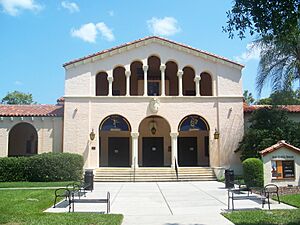
Winter Park is part of the Orange County Public Schools system.
Elementary Schools
- Aloma Elementary School
- Brookshire Elementary School
- Lakemont Elementary School
Middle School
- Glenridge Middle School
High Schools
- Lake Howell High School
- Winter Park High School
Private Schools
- Chesterton Academy of Orlando
- St. Margaret Mary Catholic School (Kindergarten to 8th grade)
- The Geneva School (Kindergarten to 12th grade)
- The Parke House Academy
- Trinity Preparatory School
Colleges and Higher Learning
- Crealde School of Art
- Fortis College, Winter Park Campus
- Full Sail University
- Rollins College
- Valencia College, Winter Park Campus
- Winter Park Tech
Transportation in Winter Park
Public Transportation
- Lynx (bus service)
- Winter Park station (for SunRail commuter trains and Amtrak long-distance trains)
Main Roads
 I-4 (Interstate 4)
I-4 (Interstate 4)
 US 17 / US 92 (Orlando Avenue)
US 17 / US 92 (Orlando Avenue) SR 423 (Lee Road)
SR 423 (Lee Road) SR 426 (Fairbanks Avenue / Aloma Avenue)
SR 426 (Fairbanks Avenue / Aloma Avenue) SR 527 (Orange Avenue)
SR 527 (Orange Avenue)
Places to Visit
- Albin Polasek Museum and Sculpture Gardens
- All Saints Episcopal Church
- Annie Russell Theatre
- Casa Feliz Historic House Museum
- Charles Hosmer Morse Museum of American Art
- Comstock-Harris House
- Downtown Winter Park Historic District
- Edward Hill Brewer House
- Hannibal Square
- Hannibal Square Heritage Center
- Knowles Memorial Chapel
- Kraft Azalea Park
- Lake Baldwin Park
- Mead Botanical Garden
- Mount Moriah Missionary Baptist Church
- Rollins Museum of Art
- Scenic Boat Tours off East Morse Boulevard
- Winter Park Historical Museum
- Winter Park Farmers' Market
- Winter Park Public Library
- Winter Park Sidewalk Art Festival
- Woman's Club of Winter Park
Famous People from Winter Park
- Dorothy Deming, a nurse and author.
- George Eddy, a US-French basketball player and announcer.
- Theodore Miller Edison, the youngest son of inventor Thomas Edison.
- Samuel Gibbs French, a Confederate Major General.
- Logan Gilbert, a professional MLB baseball player.
- Bruce Magruder, a US Army major general.
- Chris McKay, an American film director.
- Helen Monsch, a Cornell University professor.
- Stephanie Murphy, a congressperson.
- Moshe Reuven, a Hasidic music artist and tech entrepreneur.
- Fred Rogers, the famous television host of "Mister Rogers' Neighborhood." He graduated from Rollins College in Winter Park and spent many winters there.
- Austin Russell, a billionaire tech CEO.
- Willie Snead, a professional NFL wide receiver.
- Forrest Wall, a professional MLB baseball player.
See also
 In Spanish: Winter Park (Florida) para niños
In Spanish: Winter Park (Florida) para niños



